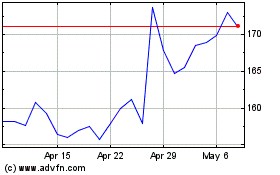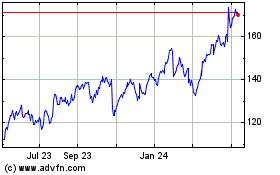By Drew FitzGerald
Online television bundles are getting bigger and prices keep
rising, edging closer to the cable bundles they were designed to
replace and muddling the economic equation that has prompted
millions of Americans to cut the cord.
YouTube TV, started two years ago as a lower-cost alternative to
cable, said this week it was raising its monthly rate by $10 to $50
and adding channels such as HGTV and Food Network. T-Mobile US
Inc., a wireless carrier that has been looking to jump into the
video business, said it would start selling a $100 monthly home-TV
service with more than 275 available channels.
The latest price increases come ahead of the introduction of new
streaming services from media heavyweights such as Walt Disney Co.
and AT&T Inc.'s WarnerMedia plus new entrants such as Apple
Inc. that could further fracture online TV and make it harder for
consumers to assemble a replacement to traditional cable.
Disney unveiled details of a new video subscription service on
Thursday, highlighting programming being made for the service based
on franchises such as "High School Musical" and "Toy Story."
Hulu and Alphabet Inc.-owned YouTube are among a host of
companies that have tried to pry loose the cable companies'
decadeslong grip on live TV by launching slimmer bundles of
channels tailored to what individual customers want to watch. But
as programmers have raised the fees they charge to carry their
channels, the online services have had a harder time holding down
prices.
Programming costs aren't guaranteed to increase. AT&T
recently negotiated reduced rates with Viacom Inc. to air channels
such as Comedy Central and MTV, according to people familiar with
the matter. Prices for AT&T's DirecTVand U-verse services
haven't declined as a result, however.
Streaming services Sling TV, DirecTV Now and Hulu, which have
signed up millions of subscribers in recent years, have all raised
the price of their lowest-tier live-TV packages over the past year.
Customers can easily disconnect or cancel the services. Providers
can likewise quickly change prices and channel packages.
AT&T executives have said they knew DirecTV Now's higher
price would drive away some customers, but needed to make the
service profitable. Rate increases at Hulu and YouTube TV were
"more opportunistic," UBS analyst Batya Levi said. "YouTube and
Hulu are the only ones that are growing right now," she said.
"There was a little bit of money left on the table" after their
rivals raised prices.
YouTube TV, which started with about 40 broadcast and cable
channels, now has over 70 and costs 43% more than it did at
launch.
"We've been working to build a package that fits your needs,"
YouTube TV Vice President Christian Oestlien wrote in a blog post
detailing the change and eight new channels from Discovery
Communications Inc. The cheaper, so-called skinny bundle that drew
its earliest customers is no longer available.
YouTube TV charges members billed through Apple a $5 monthly
surcharge, joining a group of services changing their pricing or
availability in Apple's App Store in response to the company's
policy of taking 30% of all purchases through its payment
system.
The price increase disappointed Kaushik Ghate, an early YouTube
TV adopter from San Mateo, Calif., who said he signed onto the web
service both to save money and out of distaste for cable providers.
Now that prices are closer together and Comcast Corp.'s Xfinity app
has improved, he said his decision is a toss-up.
"I am feeling let down by YouTube, as if they were supposed to
disrupt big cable" but are instead becoming more like it, he said.
"I will wait a couple of months, but now will be open to
'switching.'"
Hulu, whose owners include Disney and Comcast, illustrated a
widening gap between on-demand brands and cablelike bundles that
carry live sports and news. The website in January lopped $2 off
the monthly cost of its basic library of situation comedies and
original dramas but added $5 a month to its live-TV package. Hulu +
Live TV, which has more than 60 channels and includes limited
advertising, now costs $45 a month.
Dish Network Corp.'s Sling TV and AT&T's DirecTV Now are
owned by traditional pay-TV companies wary of wounding their most
lucrative business. Both services have signed up millions of new
subscribers while their satellite brands lose customers, but the
growth comes at a cost to their bottom lines.
Like Disney, AT&T is preparing to launch new on-demand
services later this year, as the two companies seek to compete with
Netflix Inc., which has also recently raised its monthly fees.
Apple previewed its TV app last month in a star-studded
presentation, but didn't disclose what programming it might carry
or what it would cost.
Online TV still undercuts traditional cable- and satellite-TV
subscriptions by avoiding service fees and charges for add-ons such
as DVR rentals. While U.S. television households with pay-TV
services fell to about 78% last year, off from 87% in 2008, the
amount they spend on such services hasn't, according to annual
surveys by industry tracker Leichtman Research Group. The average
home spent $107 a month on pay-TV service in 2018, according to
Leichtman's phone survey of 1,100 adults last fall.
Cord-cutters still need a high-speed internet connection that
often comes from cable providers, complicating the equation. Those
providers typically discount broadband service when it is packaged
with television, but the price jumps when it is sold by itself.
T-Mobile last year paid $325 million to buy Layer3 TV, a
cablelike service offered in a few cities, with the goal of
designing a nationwide mobile video service for its cellphone
customers. But the service has struggled to gain the carriage
rights it needs to air many channels, said people familiar with the
matter.
T-Mobile's service, rebranded TVision Home, is limited to eight
cities, including Chicago, Los Angeles and New York. The cellphone
carrier's customers can get a $10 monthly discount, but its total
cost approaches those from competing cable services and doesn't
include a broadband connection. Like a traditional cable feed, it
requires a set-top box connected to a television. The wireless
carrier says a mobile version of the service is still in the
pipeline.
"That's not very disruptive," BTIG analyst Walt Piecyk wrote in
a note to clients. "T-Mobile is offering a service that is nearly
identical to those from existing providers, even down to the remote
control, which actually has legacy cable buttons of red, green,
yellow and blue."
--Benjamin Mullin contributed to this article.
Write to Drew FitzGerald at andrew.fitzgerald@wsj.com
(END) Dow Jones Newswires
April 11, 2019 20:29 ET (00:29 GMT)
Copyright (c) 2019 Dow Jones & Company, Inc.
Alphabet (NASDAQ:GOOG)
Historical Stock Chart
From Mar 2024 to Apr 2024

Alphabet (NASDAQ:GOOG)
Historical Stock Chart
From Apr 2023 to Apr 2024
